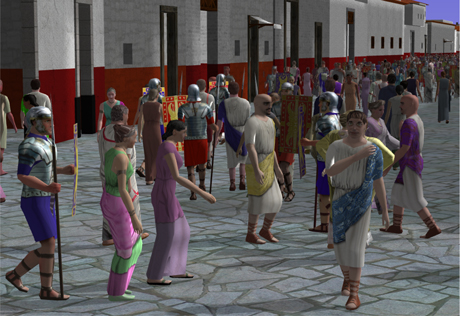EPOCH is a network of about one hundred European cultural institutions collaborating to improve the quality and effectiveness of the use of Information and Communication Technology for Cultural Heritage. Participants include university departments, research centres, heritage institutions, such as museums or national heritage agencies, and commercial enterprises, together endeavouring to overcome the fragmentation of current research in this field. The network has been coordinated by Professor David Arnold of the University of Brighton, UK.
The project has produced a number of important research prototypes and applications, far too numerous to list here. Some of the main results have been in the area of visualization, where several groups of partners have been working. One team formed by ISTI-CNR and the Universities of Leuven and Bonn has produced a 3D Multimedia Kiosk, an integrated turnkey solution, specially tailored for the needs and requirements of 3D models in museums providing affordable and easy to use technologies from 3D capturing to 3D presentation authoring and visualisation. The Polytechnic of Zurich led a team on 3D procedural modeling, applying it to the reconstruction of ancient cities (Pompeii was on display at the event and can be seen on EPOCH's web site). This work has been integrated with the virtual humans produced by a group including the Universities of Brighton, East-Anglia, Geneva and the Polytechnic of Lausanne. Another team formed by ISME, CNRS and institutions from Portugal, UK and Austria has worked on underwater applications. The University of Bologna with Kent University has produced a toolkit for context-aware heritage applications; this was demonstrated at the exhibition complementing the Rome Conference. Less spectacular, but nevertheless of great potential, is the tool designed for mapping from different data structures to the CIDOC-CRM ontology, based on an extensive analysis of standards currently in use in the heritage domain.

However, the results of the NoE have not been only software. Other significant outcomes include for example the Research Agenda, listing priorities and describing research directions for IT applications to CH; the study of the socio-economic impact of IT applications, producing decision models for the use of heritage managers; and a number of training courses and summer schools, capitalizing the experience through the proposal of a syllabus for Digital Heritage studies supported by a number of European Universities. Other examples of the durable impact of EPOCH's activity are the London Charter, a guideline for the use of 3D visualization in the research and communication of our heritage, now supported by an independent organization (www.londoncharter.org); and EPOCH's substantial contribution to the MIBAC (Italian Ministry of Culture) good practice guidelines for 3D. All these results are described in detail on the EPOCH website where it is also possible to download software packages and demos.
However, perhaps the most notable achievement of EPOCH has been to succeed in a goal that was stated in its program but found many sceptics even among its proponents. It has created durable integration among most if not all of its partners, which now form a new trans-national research community. Stable research teams have been newly formed. Researchers have moved temporarily or permanently to partner institutions in other countries. New joint projects have been launched or are forthcoming. Thus, and despite its name, the Rome event does not celebrate an end: it celebrates also the beginning of a new, and perhaps more interesting, challenge in the integration between ICT and Cultural Heritage.
Link:
http://www.epoch.eu/
Please contact:
Franco Niccolucci
STARC, The Cyprus Institute
E-mail: f.niccolucci![]() cyi.ac.cy
cyi.ac.cy










